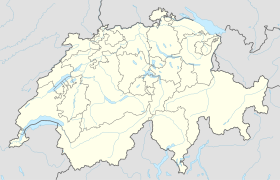Montmagny VD
| VD is the abbreviation for the canton of Vaud in Switzerland and is used to avoid confusion with other entries of the name Montmagny . |
| Montmagny | ||
|---|---|---|
| State : |
|
|
| Canton : |
|
|
| District : | Broye-Vully | |
| Municipality : | Vully-les-Lacs | |
| Postal code : | 1587 | |
| former BFS no. : | 5459 | |
| Coordinates : | 567 418 / 197313 | |
| Height : | 565 m above sea level M. | |
| Area : | 3.77 km² | |
| Residents: | 178 (December 31, 2010) | |
| Population density : | 47 inhabitants per km² | |
| Website: | www.vully-les-lacs.ch | |
| map | ||
|
|
||
Montmagny was a municipality in the Broye-Vully district in the canton of Vaud in Switzerland . It went up on July 1, 2011 in the new municipality of Vully-les-Lacs .
geography
Montmagny is 565 m above sea level. M. , 13 kilometers northeast of the district capital Payerne (linear distance ). The village extends on the ridge of the ridge between Lake Neuchâtel and Lake Murten , in a panoramic location around 130 m above the Broye plain in the Swiss plateau .
The area of the 3.8 km² municipal area covers a section west of Lake Murten. The northern part of the municipality is located on the Molasse ridge of Montmagny, the southwestern foothills of Mont Vully . At the edge of the village is 572 m above sea level. M. reached the highest point of the municipality. To the north the area extends into the Bois Rosset forest in the headwaters of the village stream of Cudrefin; to the west, Montmagny is part of the Bois de Charmontel . In a narrow strip, the communal soil extends south into the broad, agriculturally intensively used area of the Broye plain and extends over the canalized rivers of the Petite Glâne and the Broye to the area beyond the Arbogne . In 1997, 3% of the municipal area was settled, 19% forest and woodland, 76% agriculture and a little less than 2% was unproductive land.
The hamlet of La Fenette ( 540 m above sea level ) on the southern slope below the village and a few individual farms belong to Montmagny . Neighboring municipalities to Montmagny were Cudrefin , Bellerive , Constantine , Avenches , Villars-le-Grand and Chabrey .
population
With 178 inhabitants (as of December 31, 2010), Montmagny was one of the small communities in the canton of Vaud. 80.8% of the residents are French-speaking, 12.8% German-speaking and 2.6% Portuguese-speaking (as of 2000). The population of Montmagny was 201 in 1860 and 191 in 1900. After the population had decreased to 129 people by 1990, a slight increase in population has been registered since then.
economy
Until the second half of the 20th century, Montmagny was a predominantly agricultural village. Even today, the have farming and fruit growing an important role in the employment structure of the population. On the slope south of the village there is a small wine-growing area . Further jobs are available in local small businesses and in the service sector. In the last few decades the village has also developed into a residential community thanks to its attractive location. Some workers are commuters who work in the surrounding larger towns.
traffic
The community is very well developed in terms of traffic, although it is located off the main thoroughfares on a road connecting Salavaux to Chabrey. The Avenches motorway junction on the A1 (Lausanne-Bern) is around 7 km from the town center. The Postbus course that runs from Avenches to Cudrefin, Montmagny is connected to the public transport network.
history
The first written mention of the place took place in the 13th century under the name Mons Manniaco ; In 1458 the name Montmagniel appeared . The place name is derived from the Latin Mons Magniacus , probably a family with the surname Magn (i) us lived near Montmagny .
In the Middle Ages, Montmagny belonged to the Savoy Castlanei Cudrefin. With the conquest of Vaud by Bern in 1536, the village came under the administration of the Bailiwick of Avenches . After the collapse of the Ancien Régime , Montmagny was annexed to the canton of Friborg during the Helvetic Republic in 1798 . When the Mediation Constitution came into force in 1803, the village, together with what is now the Avenches district, was reassigned to the Canton of Vaud as an exclave. Until 1811, Montmagny formed a large community with the neighboring villages of Bellerive and Constantine. A preliminary study for the merger of Montmagny with Constantine, Bellerive and Vallamand is currently (2005) running .
Attractions
The water tower is the landmark of Montmagny. Montmagny does not have its own church, it belongs to the parish of Constantine . Some stately farmhouses from the 17th to 19th centuries have been preserved in the town center.
Web links
- Website of the village of Montmagny (French)
- Gilbert Marion: Montmagny. In: Historical Lexicon of Switzerland .


